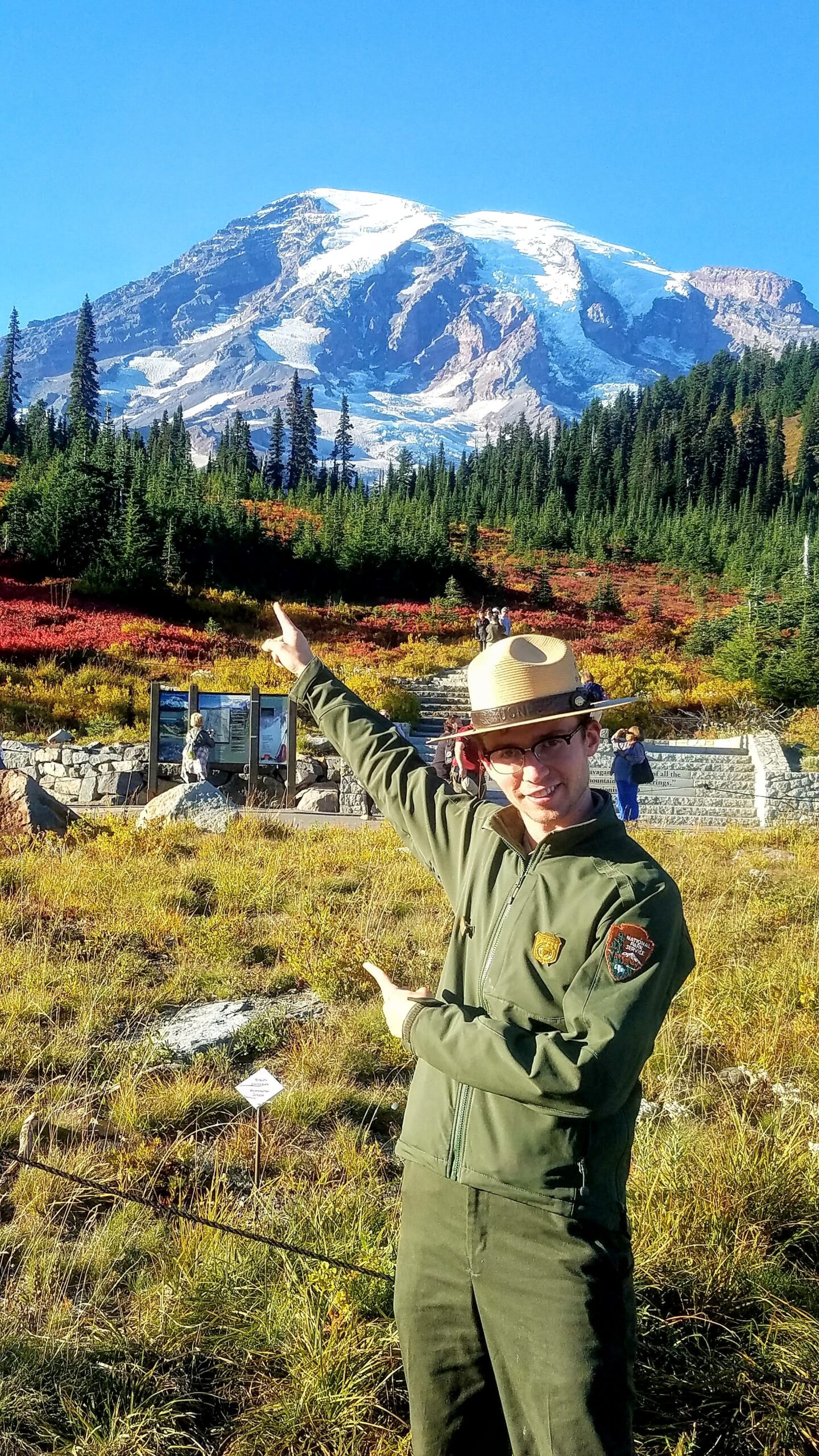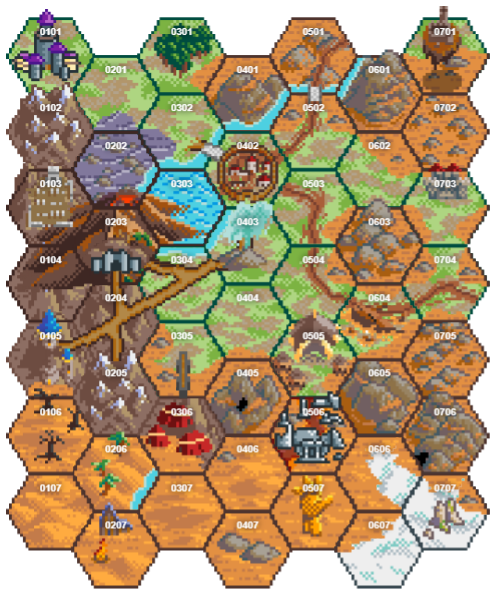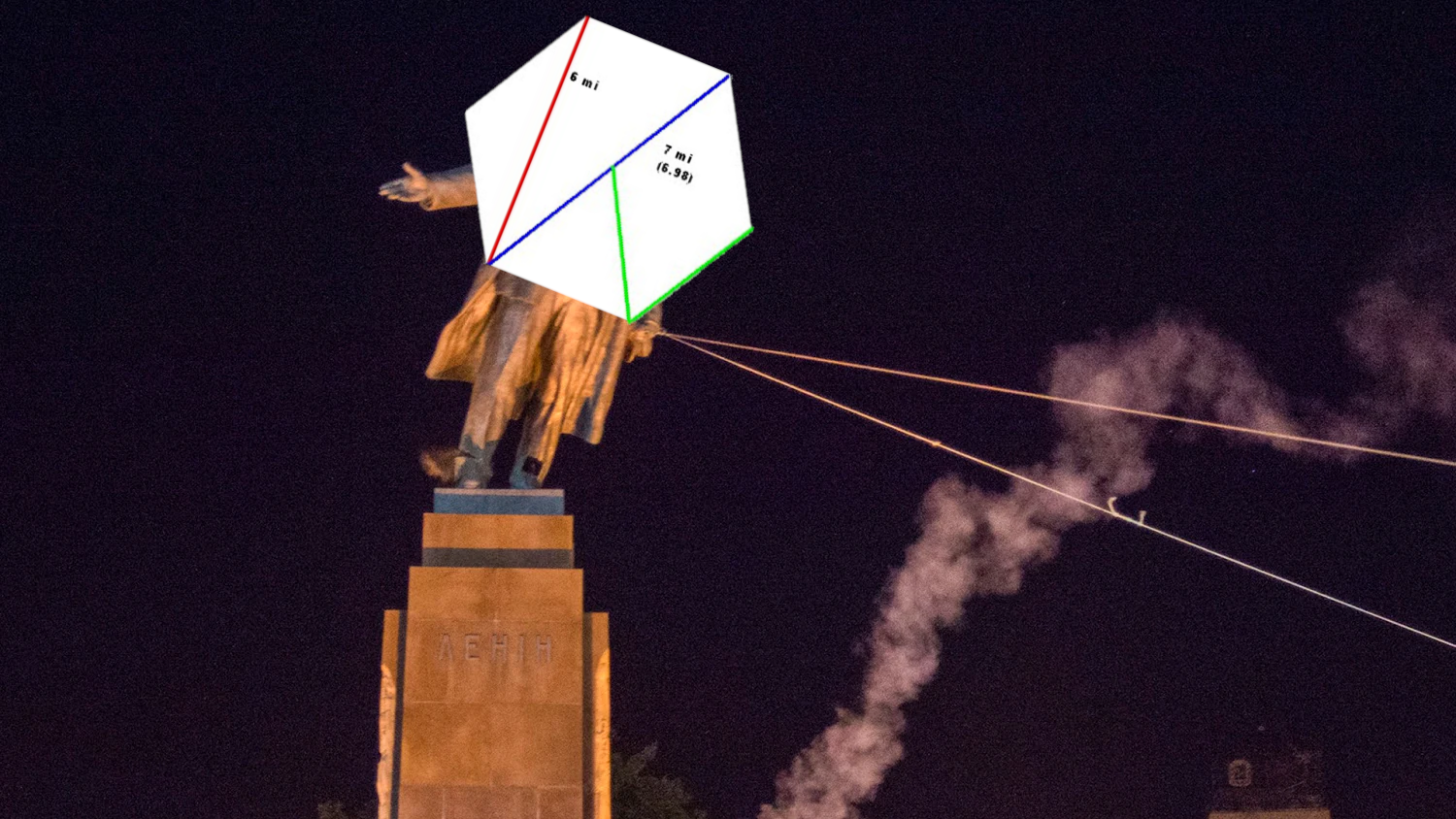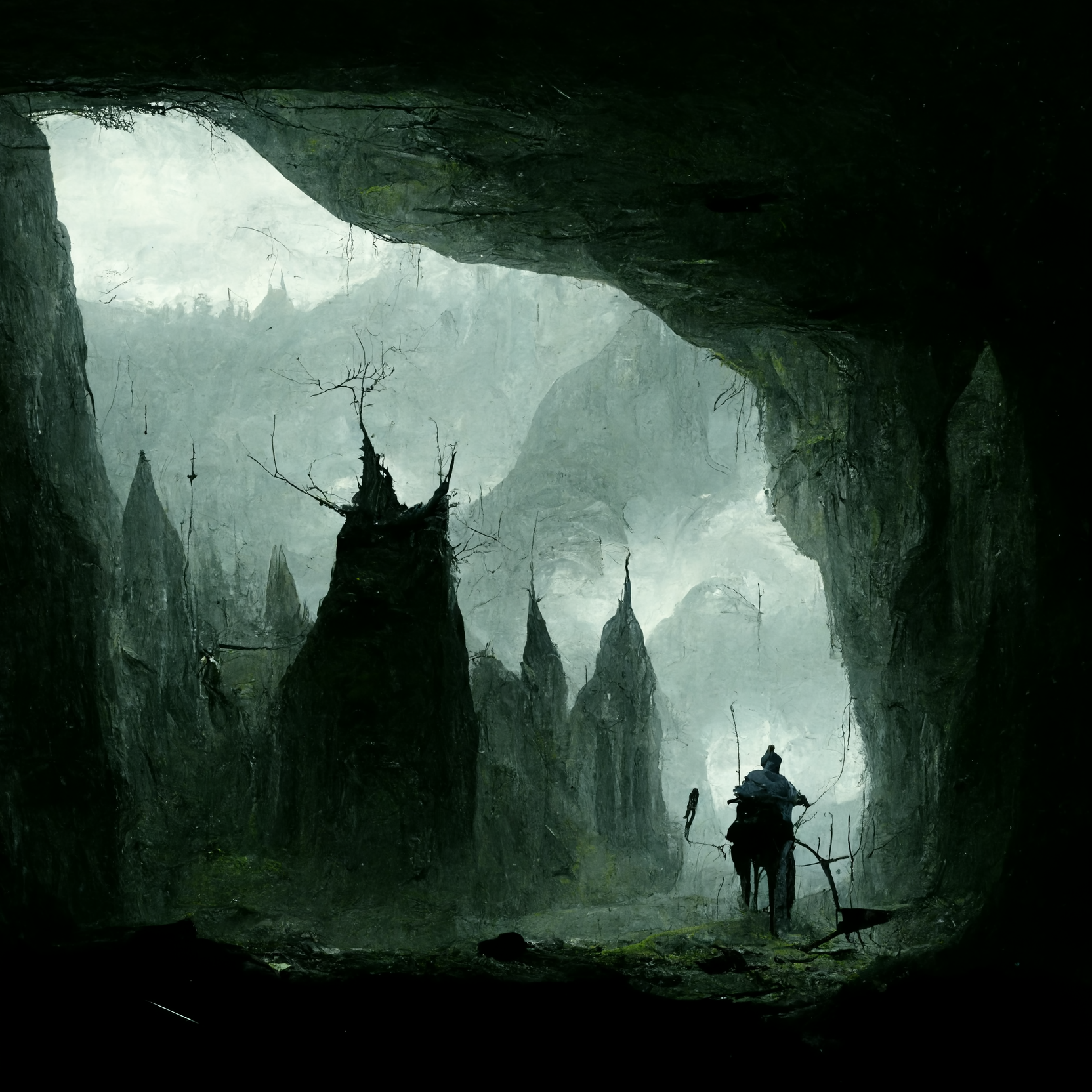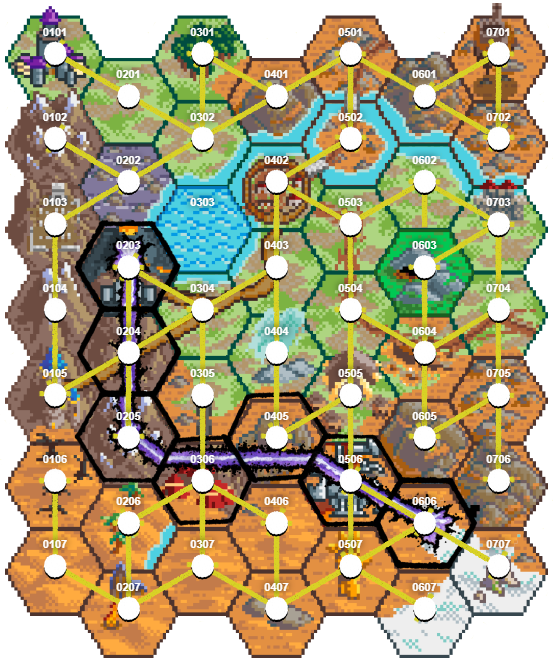This is going to be one of those posts where someone says how Game Mastering in RPG’s is basically a lot like part of their work experience in another field. I’ll also get into the dangerous arena of providing GM advice. I’d like to tell you I’ll avoid cheesy reaches to fit the framework but make absolutely no guarantees.
“A GM wears many hats… just like a ranger!”
If you’ve been to a national park in the US you’ve probably seen an interpretive park ranger, they’re at the visitor center giving out maps and directions, giving campfire talks and slideshow programs, managing social media, and leading hikes. This was my main job before I started publishing and writing RPG material at Silverarm and the job I’m returning to for the summer season tomorrow again.
If the writing and publishing enterprise ever goes catastrophically belly up, it’s basically the only other career I’m any good at. There’s pros (gorgeous sunsets, strong community, lots of bears and marmots, feeling good about the work you’re doing) and cons (no healthcare for seasonal employees, bureaucratic red tape, increasingly underfunded agency budgets, and isolation), but overall I can definitely say I haven’t regretted my time wearing the funny hat.

Interpretation isn’t really education as there isn’t a desired specific pedagogic outcome. It’s the art of talking about vibes and trying to grapple with a big picture around the facts. A lot of the times when I say I did interpretive park ranger work people misunderstand and ask me what language I was interpreting for visitors. It’s a good question and not unrelated to what the work entails. It’s about the attempt to imperfectly translate environments, history, and broad ideas into a small amount of relatable human language that serve to ideally connect the visitor to an idea of some greater and unemcompassable whole- that of the place itself. This is not unlike what a GM tries to do at the table to translate the vistas of the private worlds inside their skulls into a place that players can comprehend and interact richly with.
It’s less important that someone walks away knowing a specific detail like that Mt. Rainier is 14,411 ft tall or that a kangaroo rat can go their entire life without drinking liquid water and pees solids. It’s the feeling and the broad ideas and overarching concepts communicated by related specific details that stick with them. How will climate change affect this place? What was it like to be alive during the Civil War? What does home mean? How do things adapt to the environment they live in? What are national parks for? How should we talk about difficult history?
Some of the best interpretive themes are big questions with information that attaches to this scaffolding and provides a variety of facts and perspectives, not an authoritative thesis from a lecturing “sage on a stage” bore with all the answers. Much like good game mastering, good interpretation is informed and altered by the interests and lived experiences of the visitor experiencing the program.
If you stage a cat burglary into any national park visitor center after hours you’ll find a copy of a 1957 book called Interpreting Our Heritage by Freeman Tilden to heist in the staff library, a landmark book in the interpretive field. In the last 66 years since this dude wrote it there’s been a lot of changes in the world and interpretive field but the work has remained popular. While elements of the book’s contents, uncritical historical perspectives, and its masculine generic pronouns have become dated, it has remained a central work and a powerful reference for environmental and historical interpretive work for years. In it, Tilden lays out some principles for providing interpretive programming that doesn’t suck or bore an audience to tears.
I’ve made the change of swapping the word ‘interpretation’ with ‘game mastering’ and ‘interpreter’ with ‘game master’ in each of the 6 Principles and from other quotes I’ve included from throughout the book as I think they’re just as relevant to running RPGs as they are to interpretation.
“Principle #1: Any Game Mastering that does not somehow relate what is being displayed or described to something within the personality or experience of the visitor will be sterile.
Principle #2: Information, as such, is not game mastering. Game Mastering is revelation based on information.
Principle #3: Game Mastering is an art, which combines many arts, whether the materials presented are scientific, historical, or architectural. Any art is in some degree teachable.
Principle #4: The chief aim of Game Mastering is not instruction, but provocation.
Principle #5: Game Mastering should aim to present a whole rather than a part and must address itself to the whole man rather than any phrase.
Principle #6: Game Mastering addressed to children should not be a dilution of the presentation to adults but should follow a fundamentally different approach. To be at its best it will require a separate program.“
Here’s some elaboration on using some of Tilden’s principles in your RPG games.
Principle #1: Any game mastering that does not somehow relate what is being displayed or described to something within the personality or experience of the visitor will be sterile.
I think this is one of the core elements of running a game well. You’re not telling a personal story purely for your own enjoyment but collaborating on a shared experience that every player at the table finds engaging and interesting. This doesn’t mean that you should sacrifice your enjoyment. You have to present a world that’s relevant to your players interest and meet them at the intersection of your interests and experiences.
You need to meet people where their heads are at. Sometimes people just want to know where the bathroom is, sometimes someone wants to have a lengthy conversation on the history of the federal government displacing people from land they were already living on. The difference around the table is that being a Game Master doesn’t require being a public servant on the clock, it’s important for your players to meet you at the intersection of your interests as a participant in the game as well, everyone’s a participant at the table to have a good time.
On Immersion in the Game and Player Agency
“For remember, the visitor ultimately is seeing things through his own eyes, not those of the Game Master, and he is forever and finally translating your words as best he can into whatever he can refer to his own intimate knowledge and experience. I put the words as best he can in italics, because thus it will emphasize the importance of making this translation as easy as possible. It may not be too much to say that most history may be interpreted effectively (but of course not exclusively) by provoking the thought,‘‘Under like conditions what would you have done?’’
Freeman Tilden
As GM you words are the player’s window into this other world, everything they experience passes through the portal of your description. The situation should be detailed and their understanding of their place in it is clear. You open the door and…
“What do you do?”
To me this is the sound of freedom, I think there are no sweeter four words in a game master’s vocabulary. It’s at this moment where the player is able to walk through the portal of the imagination and use your description to inform their choices to interact with the world and the consequences of that. For my tastes as a player, the more meaningful choices I am provided with along with information to inform these choices and consequences to the actions, the better the game is. I’m preaching to the choir and understand other people have heaps of ways of enjoying RPG’s but to me an RPG session with a preplanned route and end, no matter how artfully concealed behind the GM screen is a withered dead thing, a pinned butterfly on a wall- the pale shadow of the colorful, living, erratically flapping thing it represents.
Principle #2: Information, as such, is not game mastering. Game Mastering is revelation based on information.
“People go to parks because of a keen realization that no picture or printed word, however brilliant, can do more than whet an appetite to experience with one’s own senses the grandeur and wonder nature has formed. No textbook, however instructional, can convey the feeling of reality that comes to us when we stand in the very places, among the identical objects.
Freeman Tilden
This year at GaryCon I got to play in a game with Victor Raymond and chatted afterwards about the best ways of introducing complex settings to players and some of the pitfalls folks can run into. He said something along the lines of who would you say knows more about London? Someone who’s read an intricate and lengthy Fodders travel guide to the city or someone who has actually been to London? You can recite a list of cultural facts and historical dates to your players, but the best way to learn about a setting is to play within it. You need to take them to London, Lankhmar, Sharn, or the Shire not just give them facts and lore about it to read up on.
In exploring the streets, squabbling factions, and sites of an imagined location through actual gameplay their knowledge will be acquired first hand and much more relevant and sticky through navigation of these imagined spaces. Much like there’s value and knowledge to be gained from watching a documentary about national park sites like Yosemite, Yellowstone, or Manzanar- but the sense of place and context gained through the first hand experience and context of occupying the same space and seeing the granite cliffs over the sunlit valley, herds of bison blocking an icy road, or a lone watchtower outside the site of an internment camp is more impactful.
When you describe the interior of a dungeon chamber or spaceship you’re not just telling the players about the facts. They don’t care if it has 11 dented pots and the hinges of the pots are made of copper and the drawers have 27 red forks, there’s a broom in the cover. You want to get the idea of the place across and you only have limited brain space in which to do it. Extraneous non-gameable, interactive, or evocative detail should be excised as players only attention span to take in. I’ve found that the rule of 3 is a good number to stick to for initial description about a place or situation as that seems to stick in the brain easier than a flood of extra detail but still provides enough imagery to be vivid and provoke a strong sense of place. Follow up questions from players can allow for further elaboration that’s directed by their curiosities.
Principle #3: Game Mastering is an art, which combines many arts, whether the materials presented are scientific, historical, or architectural. Any art is in some degree teachable.
This is generic enough to be cliche but I guarantee someone reading this needs to hear it. You’re going to suck some when you start because it takes time and effort to improve and that can be frustrating. I know I still suck at a lot of major GM skills after years of running. But there’s so much great resources out there to learn from and the biggest teacher is just time playing with friends and figuring out what you enjoy and don’t enjoy. Anyone can become a great GM, and you don’t need to be try to be the best GM in the world, you just need to have fun at your table. You have the capacity to improve and reach your players regardless of how bad you feel you are. The worst GM’s I’ve had were the ones who firmly believed they had perfected the art and had nothing left to learn. You have the ability within yourself and can improve these abilities through practice and passion as a journey without an end.
“The GM must use art, and at best he will be somewhat of a poet. This sounds frightening, I allow. I can see some of my readers shuddering at the thought and wondering where it leaves them. ‘‘But I never wrote a line of poetry in my life. You cannot expect me to be an artist.’’I reply: You do not know yourself. You have been so frustrated by the curatorship of unimportant details that you have forgotten your inborn talent. We are all, in some degree, poets and artists. If you mean you are not capable of the exquisite flights of a John Keats or the rumbling organ tones of a Thomas Hardy, very well. None of us are. But we can have something of the perception of a poet without having the graphic skill. We can have a sense of joy at sounding a lovely chord, without being a virtuoso.”
Freeman Tilden
Principle #4: The chief aim of Game Mastering is not instruction, but provocation.
This is one of my favorite principles. Show, don’t tell. It is up for the player to meet you in the middle through the feelings you inspire from them.
In recent years someone coined an acronym to help NPS interpreters in training frame how they approach interpretive programming using a similar principle- ORACLE(the Only Right Answer Comes from the Lived Experience). Government loves to torture a turn of phrase into a misshapen acronym.
When I heard the phrase in employee training at a park in 2018 I felt uncomfortable with it and the entirely subjective feel of it. Were basic facts about science and history to be left up to feeling? Luckily that’s not the point.
The point is that the things that resonate most deeply are those that are arrived at through the filter of a visitors particular perspective and find meaning within their individual lens they view the world with- you shouldn’t lecture people on what to feel about a topic, only provide some fuel and a spark that lights their own consideration of the thing. As a GM it’s not your job to editorialize and tell the players something is scary, awesome, disgusting, or ensure their characters react and take actions in a specific way that you think is best. It’s the unpredictability how a player will perceive and interact with part of your game due to their individual nature that makes GMing different than the lonely fun of writing a fantasy novel. All you need to provide is the tinder of the situation in your world, lit by the spark of your particular style of description that attempts to show this situation to your players. Where and how the conflagration spreads from there is out of your hands.
On Telling Players What To Feel
These Alpine peaks know how to speak for themselves, and they speak a language that the world of people shares. An object, whether a mountain, a lake, a crystal, a Chippendale or an heroic act, is not made more beautiful by being called beautiful.- And the perception of beauty is always in the nature of a surprise. We sometimes humorously call overlooks in the National Park areas‘‘ohs and ahs’’ from the fact that these exclamations are the spontaneous manner in which the visitor expresses his wonder-struck feeling. Thus, in an interpretive sign you are not wise to describe any definite object as beautiful; besides being impertinent by infringing upon the visitor’s taste, you are interposing between him and the scene.
Freeman Tilden
Principle #5: Game Mastering should aim to present a whole rather than a part and must address itself to the whole man rather than any phrase.
I think every bit of information and description provided in running a game should be focused on how it best presents the gameworld as living and complex multidimensional space. Different people also have varied interests and each player at the table will have preferences that will be met differently. Even the individual player and GM’s contain multitudes and variety in gameplay keeps things fresh. Sometimes they want to delve for gold and slaughter goblins. Even if you’re all deeply focused within a narrow subgenre of your game, there’s always room for some variation. Switching things up and providing different types of gameplay helps.
For example, a Mothership Sci-Fi Horror RPG campaign that has the adrenaline constantly cranked to 11 levels of horrifying can lose its power over time as players grow jaded and used to the non-stop terror train. Being able to breathe and experience the mundane, the suspenseful, the pleasant and the boring, make the moments of horrors much more affecting over a campaign.
In Alien like lots of great horror movies we spend a lot of time getting to know the crew and doing mundane things, arguing about shares, exploring strange structures, even experiencing some hardwon triumph at the end. It would be a much impoverished film if it was nothing but 120 minutes of chest bursting, vent crawling, and head biting. Pacing is often seen as something only prevalent in more narrative railroad styles of play but through introducing opportunities for a player directed wider variety of experiences from dungeon crawling, to intrigue, to seafaring, to goofy social interacts in your campaign the emotional highs and lows will hit harder and be more fully appreciated.
On Limiting Disconnected Background Lore in Favor of Gameable Content
It is far better that the visitor to a preserved area, natural, historic or prehistoric, should leave with one or more whole pictures in his mind, than with a melange of information that leaves him in doubt as to the essence of the place, and even in doubt as to why the area has been preserved at all.
Freeman Tilden
“…you sometimes note an impatience on the part of a specialist that the public does not show sufficient interest in his assemblage of information as such. He is likely to conclude that the average person is somewhat stupid. The opposite is true. It is a sign of native intelligence on the part of any person not to clutter his mind with indigestibles.”
Freeman Tilden
Principle #6: Game Mastering addressed to children should not be a dilution of the presentation to adults but should follow a fundamentally different approach. To be at its best it will require a separate program.
Running games for kids isn’t for everyone as the interests and temperaments of the audience can vary a lot from the adult game. It’s important to differentiate the type of game you’re playing. You’re probably not going to run a Game of Thrones political intrigue sandbox with your 11 year old cousins. There’s also lots of opportunity for really fun game play using the trends of younger groups and it’s worth spending the time tweaking your normal adult style to prepare a game that plays into those particular strengths.
General Ideas for Kids Games: (from my experience and stolen from others)
1. Kids often like to come up with creative solutions.
2. Attention spans can be short, keep things as flowing and simple as possible.
3. Chaotic murder hobo behavior is widespread. Embrace it, don’t fight it.
Ben Milton of Questing Beast and several other notable designers and GM’s are also educators and Milton frequently notes that designing for kids has improved his adult games as well with the principles of clear simplification and openness he’s learned.
On Appealing to Kids With Your RPG Game
“If we cannot interest with our treasures those carefree young persons whose minds are at the height of receptivity, how can we hope to interest those adults who are inevitably fogged and beset by the personal and social worries of an uneasy world?
Freeman Tilden
The Secret Ingredient for Running A Dungeon
I am reminded of a party of visitors I joined to explore a limestone cave. The guide was amiable and personable, but he had made two major mistakes in the work he was pursuing—without catching. In the first place,he had committed a recital to memory, and he suffered a lapse of memory before he had gotten very far. This may be a source of embarrassment to the interpreter, but it is worse for his auditors, for they do not merely bleed with him—they bleed for him. After that stoppage, our guide said, ‘‘Well, I’ll begin again. . ..’’ This time he sailed through.
But the second defect was the fatal one. He had undertaken this interpretive work without being in love. If you love the thing you interpret, and love the people who come to enjoy it, you need commit nothing to memory. For, if you love the thing, you not only have taken the pains to understand it to the limit of your capacity, but you also feel its special beauty in the general richness of life’s beauty.
Freeman Tilden
Anything written without enthusiasm will be read without interest. You must be in love with your material.
As GM’s we are guides to unknown caverns within the world, strange and distant stars, and soaring palaces of crumbling obsidian. Memorizing the exact route, planning the excursion to every moment and expecting no deviations whatsoever will not let players have an experience of exploring these fantastical places on their own without respect for their interests and self directed pathfinding. We are never able to reveal the whole fantastical vista that lies in our mind.
Our words and descriptions will never translate the whole of our imaginations to the tabletop. But when I’ve GM’d or played in my favorite games it’s the ones where we had collectively summoned this other world and together were there, sharing that fantastic landscape as a living creation of multiple engaged minds. There’s tons of skills to learn and there’s whole worlds of blogs, books, and advice videos to help you hone those and improve your Game Mastering but it takes that first ingredient to make the journey worthwhile.
Game Mastering at its best- is an act of love. Love for these games and their inspirations. Love for these otherworlds in your head. Love for yourself, your players, and that shared experience at the table. I don’t care if it sounds cheesy. We only have so many moments of real life to spend how we want, we might as well care deeply about what we spend them on.
Bonus Quotes from Tilden Applied to Gaming:
On Fancy Home Gaming Setups and Digital Tabletops:
No institution should install any mechanical devices until it knows that such gadgets can be adequately, continually, and quickly serviced. No matter how good they may be when they are working properly, they are a source of shame when they are allowed to be more than briefly inoperative; Gadgets do not supplant the personal contact.
On Experiences With Difficult People
“In the course of a long career, the GM will meet the pestiferous, the un-manageable, the ineducable, and some whose apparent reason for existence is to provide the hangman with work. These are not the many; they are the few. One who has suffered a number of attacks by poison ivy may get the idea that this malicious plant dominates the scenery. In truth it occupies only a little space in the whole floral luxuriance.”


